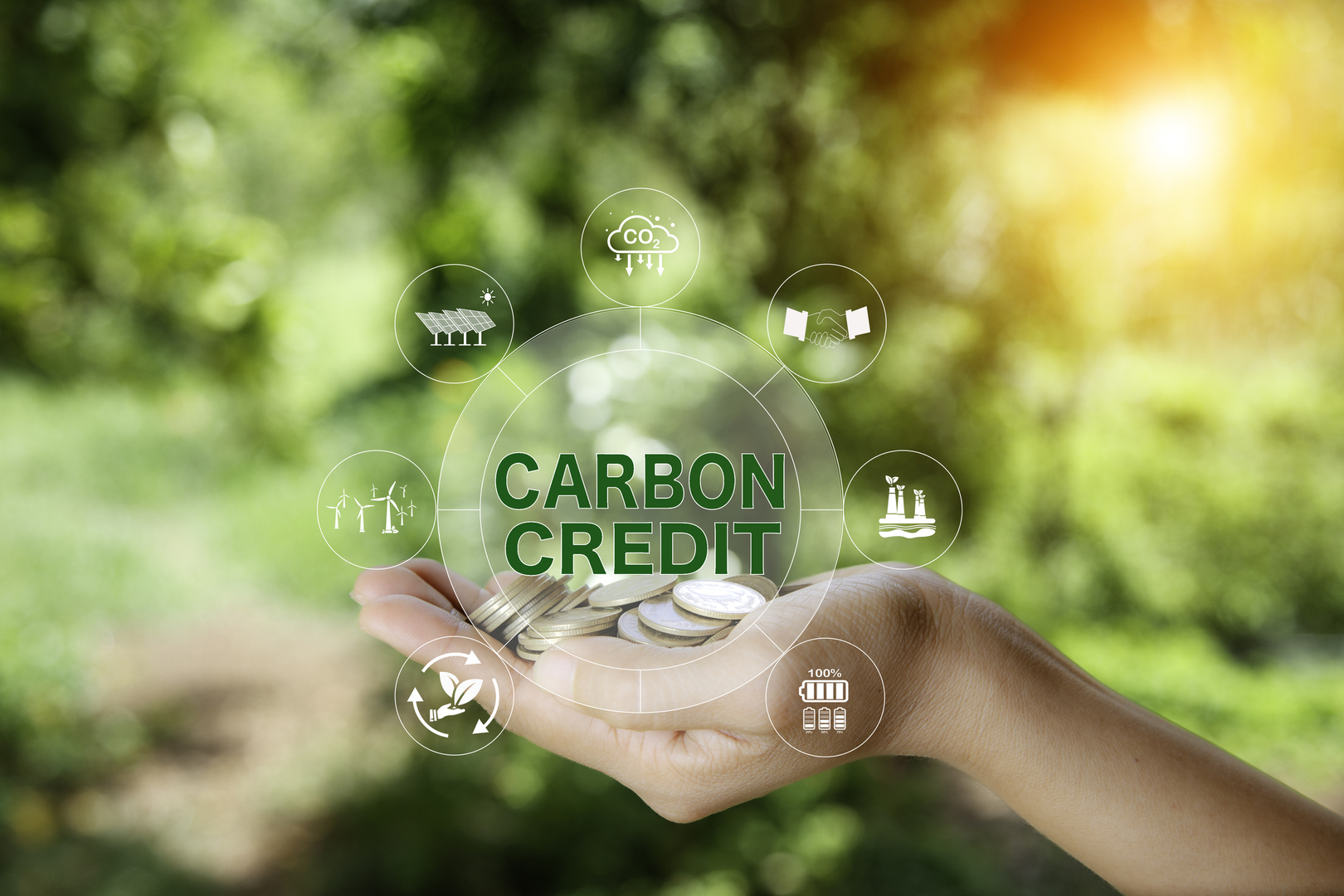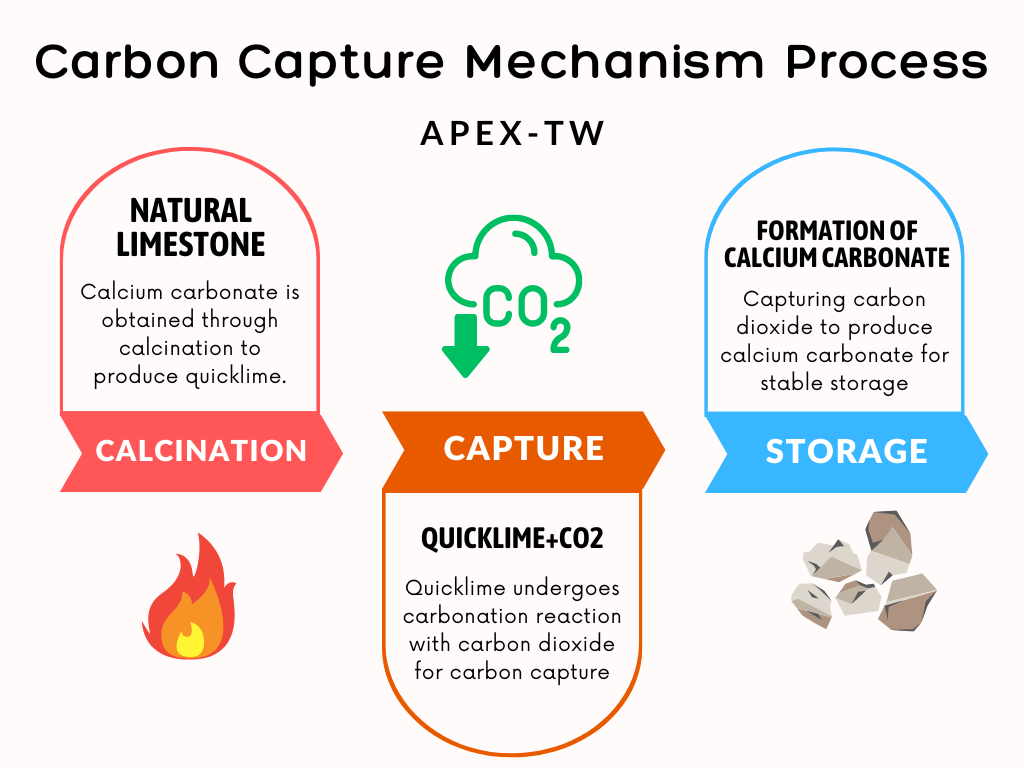


The Path to Carbon Neutrality with CBAM: The Advantage of Lime in Carbon Capture
Introduction
With the arrival of CBAM, global manufacturers are facing unprecedented challenges in carbon neutrality. This mechanism imposes carbon tariffs on imported products, not only intensifying market competition but also compelling global enterprises to reassess their carbon footprint to embrace the global wave of carbon neutrality.
Lime plays an indispensable role in the process of carbon neutrality. It holds potential value in the carbon trading arena and demonstrates outstanding advantages in carbon capture, making it a strategic asset that global enterprises must leverage. Lime produced by APEX-TW has gained a competitive advantage in reducing corporate carbon footprints and implementing CBAM.
APEX-TW's lime not only actively participates in the carbon trading market but also effectively reduces corporate carbon costs. The widespread application of lime realizes the concept of green development and enables enterprises to better address the challenges brought by CBAM. In this transformative moment, global enterprises have an excellent opportunity to lead the new wave of carbon neutrality and lay a solid foundation for future sustainable development.

The Carbon Border Adjustment Mechanism (CBAM) originated from the climate policy development of the European Union (EU). Europe has been committed to reducing carbon emissions and addressing climate change, and CBAM is an extension of its climate policy. The establishment of CBAM is primarily aimed at addressing the issue of carbon emissions from imported products not being constrained by Europe's emission reduction policies, ensuring that the carbon footprint of imported products aligns with Europe's climate goals.
As global climate change issues become increasingly severe, Europe has realized that simply implementing domestic emission reduction policies is insufficient to effectively control global carbon emissions. Therefore, CBAM represents a new initiative for Europe in the areas of carbon trading and carbon neutrality. Through the carbon border adjustment mechanism, the carbon costs of imported products are taken into account, further promoting the reduction of global carbon emissions.
The proposal of CBAM not only represents a bold move by Europe in climate action but also reflects the concept of global cooperation and carbon markets. This mechanism is expected to take effect in 2026, imposing carbon tariffs on products imported into the European Union, which will have profound implications for global businesses and manufacturing industries, prompting companies to accelerate the adoption of low-carbon production and green innovation.
Increase in Carbon Tariffs:
The primary objective of CBAM is to ensure that the carbon costs of imported goods are adequately reflected, prompting global enterprises to comply with Europe's climate goals. This results in an increase in carbon tariffs on goods exported to Europe globally, affecting the prices and competitiveness of products.
Rise in Production Costs:
Affected by carbon tariffs, global industries may face an increase in production costs. Companies need to address higher carbon costs by adjusting production methods, adopting more environmentally friendly technologies, or seeking other ways to reduce carbon footprints.
Intensified Market Competition:
The implementation of CBAM may lead to intensified global market competition, especially in industries with close trade relations with Europe. Enterprises need to adapt cautiously to maintain competitiveness in the carbon trading environment.
Demand for Technological Upgrades:
CBAM encourages companies to adopt low-carbon production technologies, which may drive technological upgrades in global industries, investment in more environmentally friendly production methods, and processes.
Increase in Carbon Neutrality Investments:
Global enterprises may need to increase investments in renewable energy and other carbon-neutral technologies to meet CBAM standards. Participation in carbon trading markets may become part of companies' carbon neutrality goals.
Affected Industries:
(1) Heavy Industries:
Sectors such as steel, cement, and fertilizers typically have higher carbon emissions, making them more susceptible to the impacts of CBAM. Adjustment of production methods and adoption of cleaner technologies (e.g., carbon capture) are necessary to avoid an increase in carbon tariffs.
(2) Energy:
Including industries such as coal and natural gas. More investments in renewable energy are needed to reduce carbon emissions while increasing energy efficiency.
(3) Chemical Industry:
Chemical production processes often involve considerable carbon emissions. Affected by CBAM, investments in cleaner production technologies are needed to meet European carbon standards.
(4) Manufacturing:
Any manufacturing industry with high carbon emissions in the production process may be impacted. This includes automotive manufacturing, electronics manufacturing, etc., requiring adjustments in supply chains and production processes to comply with European carbon standards.
Challenge: Increased Costs Due to Carbon Tariffs
Strategy: Setting Carbon Neutrality Goals
Enterprises should establish carbon neutrality goals and formulate strategies to ensure that their carbon emissions comply with CBAM standards. This may include assessing current emissions, developing emission reduction plans, reducing carbon footprints, and continuously improving.。
Challenge: Intensified Market Competition
Strategy: Technological Upgrades and Innovation
Enterprises should invest in research and development and adopt low-carbon production technologies to increase production efficiency while reducing carbon emissions. Additionally, promoting green innovation and exploring more environmentally friendly production methods and materials help maintain a competitive edge in the market.
Challenge: Pressure from Carbon Trading
Strategy: Carbon Neutrality Investments
Companies can consider investing in renewable energy and other carbon-neutral technologies to offset their carbon footprints. Participation in carbon trading markets through the purchase and sale of carbon credits helps balance a company's carbon emissions.
Challenge: Compliance with Stricter Carbon Emission Standards and Regulations
Strategy: Compliance and Transparency
Enterprises should enhance their understanding of regulations to ensure transparency in carbon emissions. Establishing compliance mechanisms to address new regulatory requirements helps reduce regulatory risks.
Carbon capture, also known as Carbon Capture and Storage (CCS), is a technology aimed at reducing the concentration of carbon dioxide (CO2) in the atmosphere to combat global warming and climate change. This technology involves three main steps: capture, transport, and storage.
This phase involves capturing carbon dioxide from industrial processes or power generation. This can be achieved through various methods, including chemical absorption, physical absorption, and low-temperature separation.
Once carbon dioxide is captured, it needs to be transported to a storage site. This is typically done through pipelines or by shipping it in liquid form.
The final stage is to permanently store carbon dioxide underground to prevent it from entering the atmosphere. This is usually done in depleted oil fields, natural gas fields, or deep-sea saline formations.

1. Carbon Capture Capability:
Lime serves as an excellent carbon capture agent, effectively adsorbing and transforming carbon dioxide (CO2) into calcium carbonate. This carbon capture capability makes lime an important tool for reducing corporate carbon emissions.
2. Reducing Carbon Footprint:
Using lime enables companies to effectively reduce carbon emissions generated during their production processes, thereby lowering their overall carbon footprint. This not only helps companies fulfill their social responsibilities but also aligns with the global trend of carbon neutrality.
3. Participation in Carbon Trading Markets:
The use of lime allows companies to actively participate in carbon trading markets. Through carbon capture during the production process, companies can generate transferable carbon credits, which become a strategic asset, aiding companies in gaining a competitive edge in the carbon market.
4. Enhancing Corporate Image:
Utilizing lime for carbon capture demonstrates a company's commitment to environmental protection, contributing to enhancing its image and sustainable development. For consumers and investors, companies that support environmentally friendly practices are more attractive.
5. Adapting to CBAM Regulations:
With the implementation of CBAM, the carbon capture characteristics of lime can help companies meet or exceed CBAM's carbon footprint standards, thereby addressing new import carbon tariff regulations.
The mechanism by which lime (calcium oxide) operates in carbon capture:
Carbonation Reaction: Lime primarily captures carbon dioxide (CO2) through a carbonation reaction. Carbonation is a chemical reaction in which lime (CaO) reacts with CO2 to produce calcium carbonate (CaCO3). In this reaction, lime absorbs CO2, converting it into solid calcium carbonate.
Reaction Equation:
CaO + CO2 → CaCO3
(Wikipedia: Carbonation Reaction)
Solidification of Calcium Carbonate: The generated calcium carbonate is a solid that can be stably stored or used for other purposes. This solid calcium carbonate can be stored in facilities or storage sites, preventing the release of CO2 back into the atmosphere.
This carbon capture mechanism makes lime a material with excellent carbon capture capabilities. Its carbonation reaction is a reversible process, where stored CO2 can be released when calcium carbonate is heated. Therefore, lime is widely used in carbon capture and storage technologies, particularly playing a significant role in reducing industrial emissions and achieving carbon neutrality goals.
Quicklime, also known as calcium oxide, is an inorganic substance derived from the decomposition of limestone at high temperatures. It plays an important role in industrial production and environmental management due to its efficient adsorption and neutralization capabilities. Leveraging this characteristic, APEX-TW has developed high-quality lime products suitable for various industrial processes and environmental protection projects.
Process Overview:
High-quality limestone is carefully selected and calcined at 1100°C to produce quicklime (CaO), which is then graded and maintained to ensure complete calcination, avoiding incomplete calcination that can lead to core stone formation.
Product Features:
Medium to high alkalinity, appearing as white lumps, granules, or powder.
High product quality, with options available to meet purity and particle size requirements. Low impurities and high purity.
Applications:
Carbon Capture: Utilized in carbon capture mechanisms to effectively reduce carbon dioxide in the environment.
Environmental Neutralization: Used in wastewater purification processes; acid-base neutralization in chemical plants; drying; and removal of sulfur from waste gases.
Dehydration and Drying: Added as a desiccant in waste disposal to absorb moisture and eliminate odors; used in rubber and plastic industries for moisture absorption, anti-caking, defoaming, and drying purposes.
Whether you're seeking information about lime products, wish to understand carbon capture solutions, or have any related questions, we warmly welcome you to get in touch with us. Our professional team is dedicated to providing you with the best service and answers.
Email: [email protected]
We use cookies to collect and analyze information on site performance and usage. By Clicking "Continue" or by clicking into any content on this site, you agree to allow cookies to be placed. To find out more, please visit our privacy policy。
CONTINUE GO TOP
GO TOP
